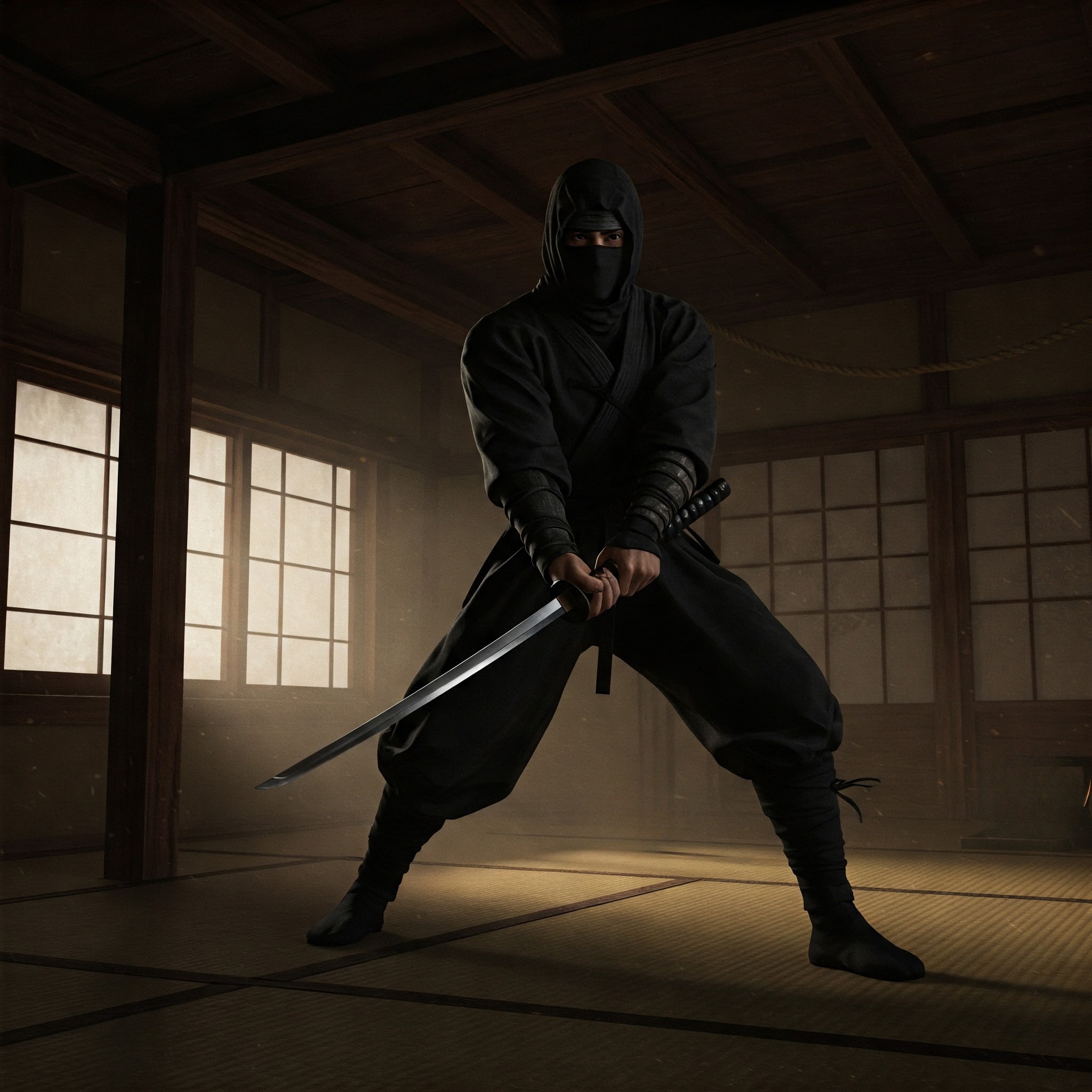忍者刀の真実:日本刀との違いとその実用性
忍者といえば、黒装束に身を包み、背中に一本の刀を背負った姿を思い浮かべる者も多かろう。しかし、その忍者刀(にんじゃとう・しのびがたな)は、我々が一般的に知る日本刀とは形状が異なるのじゃ。今回は、その 忍者刀の特徴と実際の用途 について深く掘り下げてみよう。
忍者刀と日本刀の形状の違い
一般的な日本刀は、刃が長く、反り(そり)があるのが特徴じゃ。この反りによって、流れるような斬撃が可能となる。しかし、忍者刀は 反りがほとんどない直刀に近い形状 をしておる。
忍者刀の主な特徴
- 直刀に近い形状(反りが少ない)
- 日本刀よりも短い(60~70cm程度)
- 四角い鍔(つば)
- 鞘(さや)に仕掛けがあることが多い
これらの特徴には、忍者としての 実戦的な理由 が隠されておるのじゃ。
忍者刀は「斬る」ためではなく「突く」ため?
忍者刀の反りが少ない理由について、「斬るためではなく、突くための武器だから」と言われることがある。たしかに、直刀は突き技に適しており、敵の急所を正確に狙いやすい。だが、それだけが理由ではないのじゃ。
忍者の戦いは、暗殺や奇襲が主である。 そのため、大きく振りかぶる斬撃よりも、素早く突いたり、密かに攻撃したりする方が適しておるのじゃ。また、城内や屋敷の中など、狭い場所での戦闘が多かったため、短めの刀の方が扱いやすかったのも理由の一つじゃろう。
忍者刀の四角い鍔(つば)は足場になる?
忍者刀のもう一つの特徴が 四角い鍔(つば) じゃ。一般的な日本刀の鍔は円形や楕円形が多いが、忍者刀は四角く、大きめに作られておることがある。
これは、足場として使うため という説があるのじゃ。
例えば、
- 忍者刀を壁に突き立て、鍔に足をかけてよじ登る
- 二本の忍者刀を階段のように使い、塀を乗り越える
といった使い方が伝わっておる。実際にそのような使い方がされていたかは不明じゃが、忍者が あらゆる道具を工夫して使っていた のは確かじゃ。
忍者刀は狭い場所での戦闘に適していた
忍者の戦いは、広い戦場ではなく 屋敷の廊下や狭い抜け道、屋根裏 などで行われることが多かった。そうした場面では、長い日本刀よりも、短く扱いやすい忍者刀の方が有利じゃった。
狭い場所での戦闘の特徴
- 長い刀を振り回せない → 短い刀の方が有利
- 奇襲が基本 → すばやく抜刀し、即座に攻撃
- 屋根裏や抜け道を移動することも多い → 長い刀は邪魔になる
そのため、忍者刀は コンパクトで機動性に優れた武器 であったと言えるのじゃ。
忍者刀の鞘(さや)にも工夫があった?
忍者刀は ただの武器ではなく、多機能な道具 でもあった。例えば、鞘(さや)に仕掛けを施し、息を潜めるための管(くだ) や 毒針 を忍ばせることもあったと言われる。
また、忍者は 刀を鞘に納めたまま殴る という使い方もした。これは、敵を気絶させたり、音を立てずに倒すための工夫じゃ。忍者刀は 単なる刀ではなく、様々な戦術に応じたツール だったのじゃな。
まとめ
忍者刀は、普通の日本刀とは異なり、忍者の戦術に適した形状をしておった。
- 反りが少なく、突きやすい形状
- 短めで、狭い場所でも使いやすい
- 四角い鍔を足場として利用する説がある
- 鞘に工夫を施し、多機能な道具としても活用
これらの特徴は、忍者が 単に戦うのではなく、奇襲や潜入を重視した戦術をとっていた ことを物語っておるのじゃ。
忍者とは、ただ剣を振るう戦士ではなく、知恵と工夫を駆使し、環境に適応しながら生きる者たちであったのじゃ。
現代でも、忍者の知恵は我々に多くの学びを与えてくれる。戦い方だけではなく、「柔軟に適応し、状況に応じて最適な手段を選ぶ」 という忍者の精神こそ、現代にも活かせる大切な知恵なのかもしれぬのう。
【以下英語版】【English version below】
The Truth About the Ninja Sword: Differences from the Traditional Japanese Katana and Its Practicality
When people think of a ninja, they often picture a figure clad in black, carrying a sword on their back. However, the ninja sword (ninjatō/shinobigatana) differs in shape from the traditional Japanese katana. Today, let’s delve deeper into the characteristics and actual uses of the ninja sword.
Differences in Shape Between the Ninja Sword and the Katana
A standard Japanese katana has a curved blade, designed for fluid cutting strikes. In contrast, the ninja sword is known for being almost straight, with little to no curvature.
Main Features of the Ninja Sword
- A nearly straight blade (with little curvature)
- Shorter than a typical katana (about 60–70 cm)
- A square-shaped handguard (tsuba)
- A scabbard (saya) often with hidden mechanisms
These differences weren’t merely aesthetic—they served practical purposes suited to a ninja’s tactics.
Was the Ninja Sword Designed for Thrusting Rather Than Cutting?
Some say that the ninja sword’s lack of curvature means it was intended more for thrusting than cutting. A straight blade is indeed better suited for piercing attacks and allows for more precise strikes to vital points. However, this isn’t the only reason behind its design.
Ninjas primarily engaged in surprise attacks and assassinations. In such scenarios, a large, sweeping cut was less useful than a quick, direct stab. Additionally, because ninjas often fought in tight spaces like castles and corridors, a shorter, straighter blade was simply more practical for combat.
Was the Square-Shaped Handguard (Tsuba) Used as a Footstep?
Another unique feature of the ninja sword is its square-shaped tsuba (handguard). While most katanas have round or oval handguards, ninja swords sometimes had large, square ones.
There is a theory that this handguard functioned as a step to help ninjas climb obstacles.
For example:
- Stabbing the sword into a wall and stepping on the tsuba to climb
- Using two ninja swords as makeshift footholds to scale fences
Although the historical accuracy of these techniques is uncertain, it is well-documented that ninjas used every tool at their disposal in creative ways.
The Ninja Sword Was Ideal for Fighting in Tight Spaces
Unlike samurai, ninjas often fought in confined spaces such as hallways, hidden tunnels, or attics. In such environments, a long katana was difficult to maneuver, whereas a shorter ninja sword was more effective.
Combat in Tight Spaces
- A long sword is difficult to swing → A shorter sword is more practical
- Stealth is crucial → A quick-drawing, fast-striking weapon is better
- Ninjas often moved through attics or tunnels → A long sword could get in the way
Thus, the ninja sword was not just a weapon but a tool designed for mobility and efficiency in confined environments.
Did the Ninja Sword’s Scabbard Have Hidden Features?
The ninja sword was more than just a weapon—it was a multifunctional tool. Some scabbards (saya) were said to have special modifications, such as:
- A breathing tube for underwater concealment
- Poison needles hidden inside
Ninjas were also known to strike enemies with the sheathed sword rather than drawing it. This technique could knock out enemies without making noise, proving that the ninja sword was designed for both combat and silent operations.
Conclusion
The ninja sword was not just a smaller version of the katana—it was specifically designed to match the unique fighting style and strategies of ninjas.
- A straighter blade made for thrusting rather than slicing
- A shorter design suited for combat in narrow spaces
- A square-shaped tsuba that may have been used as a foothold
- A scabbard with potential hidden tools and functions
These features reflect the fact that ninjas were not traditional warriors but tactical operatives who relied on intelligence, adaptability, and ingenuity.
Even today, we can learn valuable lessons from the ninja way—not just in combat, but in life itself. The ability to adapt to changing situations and find the best possible strategy is an essential skill that remains just as relevant in the modern world as it was in the age of the ninja.



